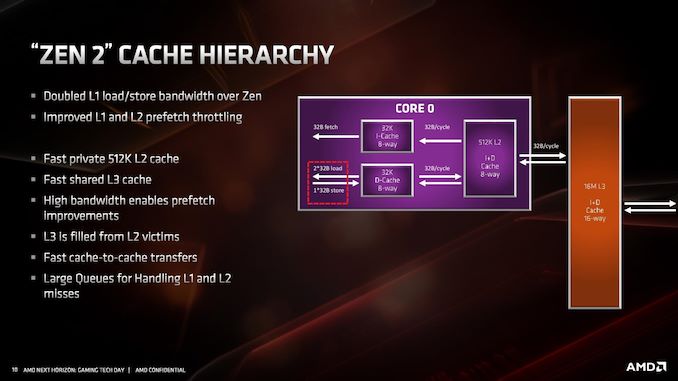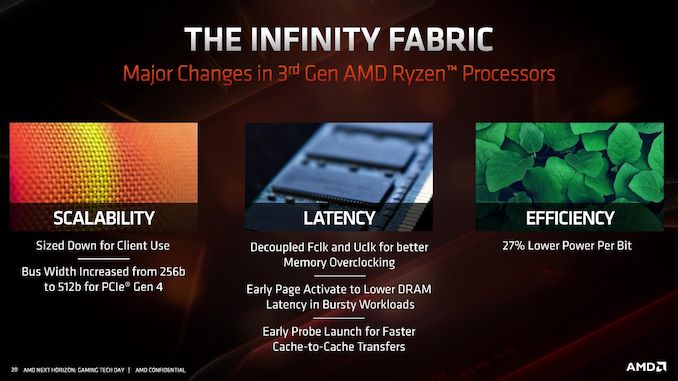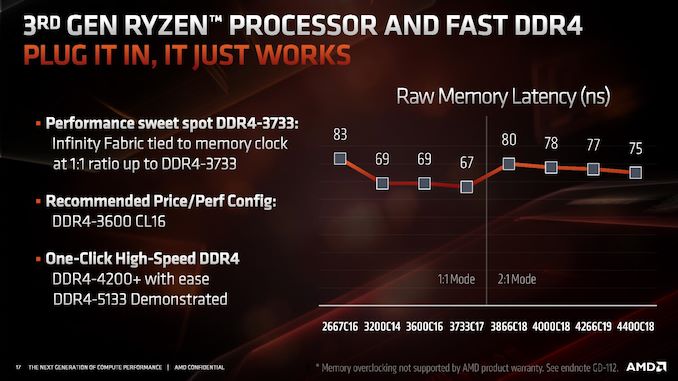AMD Zen 2 Microarchitecture Analysis: Ryzen 3000 and EPYC Rome
by Dr. Ian Cutress on June 10, 2019 7:22 PM EST- Posted in
- CPUs
- AMD
- Ryzen
- EPYC
- Infinity Fabric
- PCIe 4.0
- Zen 2
- Rome
- Ryzen 3000
- Ryzen 3rd Gen
Cache and Infinity Fabric
If it hasn’t been hammered in already, the big change in the cache is the L1 instruction cache which has been reduced from 64 KB to 32 KB, but the associativity has increased from 4-way to 8-way. This change enabled AMD to increase the size of the micro-op cache from 2K entry to 4K entry, and AMD felt that this gave a better performance balance with how modern workloads are evolving.
The L1-D cache is still 32KB 8-way, while the L2 cache is still 512KB 8-way. The L3 cache, which is a non-inclusive cache (compared to the L2 inclusive cache), has now doubled in size to 16 MB per core complex, up from 8 MB. AMD manages its L3 by sharing a 16MB block per CCX, rather than enabling access to any L3 from any core.
Because of the increase in size of the L3, latency has increased slightly. L1 is still 4-cycle, L2 is still 12-cycle, but L3 has increased from ~35 cycle to ~40 cycle (this is a characteristic of larger caches, they end up being slightly slower latency; it’s an interesting trade off to measure). AMD has stated that it has increased the size of the queues handling L1 and L2 misses, although hasn’t elaborated as to how big they now are.
Infinity Fabric
With the move to Zen 2, we also move to the second generation of Infinity Fabric. One of the major updates with IF2 is the support of PCIe 4.0, and thus the increase of the bus width from 256-bit to 512-bit.
Overall efficiency of IF2 has improved 27% according to AMD, leading to a lower power per bit. As we move to more IF links in EPYC, this will become very important as data is transferred from chiplet to IO die.
One of the features of IF2 is that the clock has been decoupled from the main DRAM clock. In Zen and Zen+, the IF frequency was coupled to the DRAM frequency, which led to some interesting scenarios where the memory could go a lot faster but the limitations in the IF meant that they were both limited by the lock-step nature of the clock. For Zen 2, AMD has introduced ratios to the IF2, enabling a 1:1 normal ratio or a 2:1 ratio that reduces the IF2 clock in half.
This ratio should automatically come into play around DDR4-3600 or DDR4-3800, but it does mean that IF2 clock does reduce in half, which has a knock on effect with respect to bandwidth. It should be noted that even if the DRAM frequency is high, having a slower IF frequency will likely limit the raw performance gain from that faster memory. AMD recommends keeping the ratio at a 1:1 around DDR4-3600, and instead optimizing sub-timings at that speed.













216 Comments
View All Comments
Ratman6161 - Friday, June 14, 2019 - link
Better yet, why even bother talking about it? I read these architecture articles and find them interesting, but I'll spend my money based on real world performance.Notmyusualid - Sunday, July 7, 2019 - link
@ Ratman - aye, I give this all passing attention too. Hoping one day another 'Conroe' moment lands at our feet.RedGreenBlue - Tuesday, June 11, 2019 - link
The immediate value at these price points is the multithreading. Even ignoring the CPU cost, the motherboard costs of Zen 2 on AM4 can be substantially cheaper than the threadripper platform. Also, keep in mind what AMD did soon after the Zen 1000 series launch, and, I think, Zen 2 launch to a degree. They knocked down the prices pretty substantially. The initial pricing is for early adopters with less price sensitivity and who have been holding off upgrading as long as possible and are ready to spring for something. 3 months or so from launch these prices may be reduced officially, if not unofficially by 3rd parties.RedGreenBlue - Tuesday, June 11, 2019 - link
*Meant to say Z+ launch, not Zen 2.Spoelie - Wednesday, June 12, 2019 - link
To be fair, those price drops were also partially instigated by CPU launches from Intel - companies typically don't lower prices automatically, usually it is from competitive pressure or low sales.just4U - Thursday, June 13, 2019 - link
I don't believe that's true at all S. Pricing was already lower than the 8th gen Intels and the 9th while adding cores wasn't competing against the Ryzens any more than the older series..sing_electric - Friday, June 14, 2019 - link
That's true, but by most indications, if you want the "full" AM4 experience, you'll be paying more than you did previously because the 500-series motherboards will cost significantly more - I'm sure that TR boards will see an increase, too, but I think, proportionately, it might be smaller (because the cost increase for say, PCIe 4.0 is probably a fixed dollar amount, give or take).mode_13h - Tuesday, June 11, 2019 - link
Huh? There've been lots of Intel generations that did not generate those kinds of performance gains, and Intel has not introduced a newer product at a lower price point, since at least the Core i-series. So, I have no idea where you get this 10-15% perf per dollar figure.Irata - Tuesday, June 11, 2019 - link
So who does innovate in your humble opinion ?Looking at your posts, you seem to confuse / jumble quite a lot of things.
Example TSMC: So yes, they are giving AMD a better manufacturing that allows them to offer more transistors per area or lower power use at the same clock speed.
But better perf/ $ ? Not sure - that all depends on the price per good die, i.e. yields, price etc. all play a role and I assume you do not know any of this data.
Moores law - Alx already covered that...
As for the 16 core - what would the ideal price be for you ? $199 ? What do the alternatives cost (CPU + HSF and total platform cost).
If you want to look a price - yes, it did go up compared to the 2xxx series, but compared to the first Ryzen (2017), you do get quite a lot more than you did with the original Ryzen.
1800x 8C/16T 3,6 Ghz base / 4 Ghz boost for $499
3900x 12C/24T 3.8 Ghz base / 4,6 Ghz boost for $499
Now the 2700x was only $329, but its counterpart the 3700x has the same price, roughly the same frequency but a lower power consumption and supposedly better performance in just the range you mention.
Spunjji - Tuesday, June 11, 2019 - link
Nice comprehensive summary there!